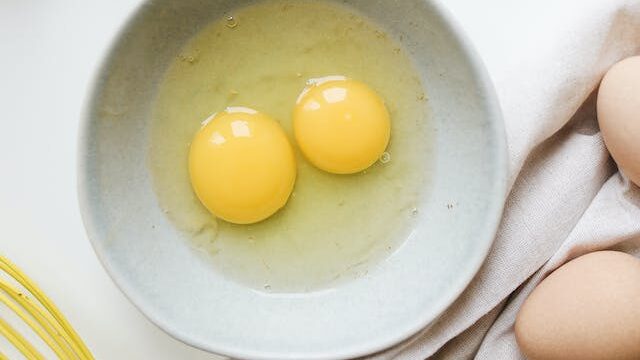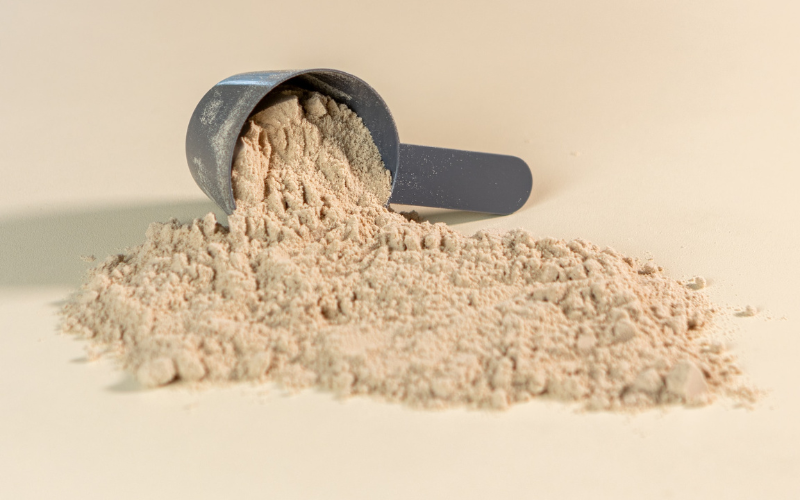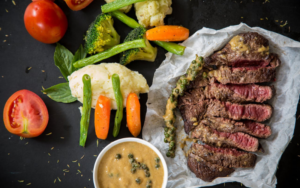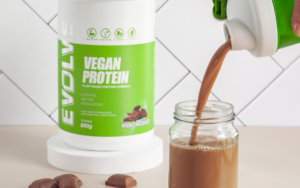Introduction
Protein powder is a staple in many health and fitness routines, popular for its ability to support muscle growth and recovery. But have you ever wondered how is protein powder made? From animal-based sources like milk and eggs to plant-based options like pea and hemp, the process of turning these ingredients into the fine powder we mix into our shakes is quite fascinating. In this article, we’ll take an in-depth look at the various methods used to create different types of protein powders, ensuring you’re well-informed about this key component of your nutrition regimen.
Key Takeaways
- Diverse Protein Sources: Protein powders are made from various sources including whey, casein, pea, hemp, and egg whites, catering to different dietary preferences and needs.
- Whey Protein Process: Whey protein is derived from milk during cheese production, undergoing processes like pasteurization, filtration, and drying to form either concentrate or isolate.
- Plant-Based Options: Pea and hemp protein powders are created through methods like grinding, mixing with water, and separating to retain essential nutrients and ensure high protein content.
- Egg White Protein Production: Egg whites are separated, liquified, dehydrated, and often flavored to form egg white protein powder, offering a high-protein, lactose-free option.
Table of Contents
Overview of Protein Powder Sources
Protein powders come from a variety of sources, each unique in its composition and benefits. Understanding these sources is key to choosing the right protein powder for your needs. Here’s a look at the most common types:
- Animal-Based Proteins: These include whey and casein from milk, and egg protein. They are complete proteins, meaning they contain all nine essential amino acids necessary for muscle building and repair.
- Plant-Based Proteins: Popular plant sources are pea, soy, rice, and hemp. These are great alternatives for vegans or those with lactose intolerance. While some plant proteins are complete, others may need to be combined to ensure all essential amino acids are present.
Types of Protein Powders
| Protein Source | Type | Key Characteristics |
|---|---|---|
| Whey | Animal-Based | Complete protein, fast-digesting |
| Casein | Animal-Based | Complete protein, slow-digesting |
| Egg | Animal-Based | Complete protein, lactose-free |
| Pea | Plant-Based | Often combined with other plant proteins |
| Soy | Plant-Based | Complete protein, popular vegan option |
| Rice | Plant-Based | Usually combined with other plant proteins |
The Process of Making Whey Protein Powder
Whey protein powder, a byproduct of cheese production, is one of the most popular protein supplements. Its journey from cow’s milk to a finely milled powder is a fascinating process.
From Cow to Curd: The Initial Steps
- Milking and Collection: It all starts with milking cows. The collected raw milk is then cooled to around 4 degrees Celsius to maintain freshness.
- Transportation: The milk is transported in refrigerated tanks to a cheese-making facility.
- Pasteurization: Upon arrival, the milk is pasteurized at 72-73 degrees Celsius to eliminate bacteria and then re-cooled.
Cheese Processing and Whey Separation
- Cheese Production: The milk undergoes cheese processing, where enzymes are added to coagulate the milk, separating it into curds (solid) and whey (liquid).
- Whey Draining: The liquid whey, which was once considered a waste product, is drained off for further processing.

Refining Whey into Powder
- Filtering for Concentrate: The liquid whey is filtered to remove some lactose and minerals, resulting in whey protein concentrate (WPC), which typically contains 70-80% protein.
- Microfiltration for Isolate: For a higher protein content, whey undergoes microfiltration to become whey protein isolate, which has a protein concentration of about 90%.
- Ultrafiltration for Purity: Further ultrafiltration processes produce WPC-80, a more refined form of whey concentrate.
Final Steps: Flavoring and Packaging
- Flavoring: Due to whey’s natural taste, flavors and sweeteners are often added to make the protein powder palatable.
- Spray Drying: The flavored liquid is then spray dried using hot and cold air to create a fine powder.
- Packaging: Finally, the protein powder is packaged into large bags for storage and distribution.
Making Plant-Based Protein Powders: Pea and Hemp
Plant-based protein powders, such as pea and hemp, are becoming increasingly popular, especially among those following vegan or vegetarian diets. Let’s explore the detailed processes behind making these two types of protein powders.
How is Pea Protein Powder Made?
Pea protein powder, derived from yellow split peas, is known for its digestibility and suitability for those with stomach sensitivities.
The Two-Phase Process
- Dry Phase:
- Drying and Grinding: The peas are first dried and then ground into a fine flour-like powder, which contains protein, starch, and fiber.
- Liquid Phase:
- Mixing with Water: This powder is mixed with water, allowing the separation of fiber and starch from the protein.
- Creating Concentrate and Isolate: The resulting product can be processed into pea protein concentrate or further into pea protein isolate for higher protein content.
Nutritional Value
- Pea protein powders retain natural vitamins and minerals, like Vitamin A, iron, folate, and manganese.
How is Hemp Protein Powder Made?
Hemp protein comes from a variation of the cannabis sativa plant and is valued for its omega fatty acid content and mineral richness.
The Hemp Processing Steps
- Harvesting and Cleaning:
- Hemp plants are harvested, cleaned, and dried. This involves sieving, grading, and gravity separation.
- Dehulling:
- The seeds are dehulled, meaning their outer shells are removed.
- Oil Extraction:
- Hemp oil is extracted, leaving behind hemp cake or meal, the base for hemp protein powder.

- Milling and Separation:
- The hemp meal is milled and separated to obtain a fine powder.
Digestibility and Nutritional Value
- Hemp protein is highly digestible, with studies showing 91% to 98% digestibility.
- It contains proteins like albumin and edestin, which are easily absorbed by the body.
Comparison Table of Pea and Hemp Protein Powders
| Protein Type | Process | Key Features |
|---|---|---|
| Pea Protein | Dry and liquid phase separation | Rich in essential vitamins and minerals |
| Hemp Protein | Harvesting, dehulling, milling | High in Omega fatty acids and digestible protein |
Both pea and hemp protein powders offer unique benefits and are made through processes that ensure the retention of their natural nutrients, making them excellent choices for those seeking plant-based protein options.
Creating Egg White Protein Powder
Egg white protein powder is another popular choice, especially for those who are lactose intolerant or allergic to milk. The process of turning egg whites into a fine powder involves several steps.

Separation and Dehydration
- Egg Cracking and Separation:
- The first step is to separate the egg whites from the yolks. This is typically done mechanically in large processing facilities.
- Liquidfication for Storage:
- The separated egg whites are then liquified for easier storage and handling. This liquid can be stored for days before further processing.
- Dehydration Process:
- The liquified egg whites are dehydrated, usually through a spray drying process, turning them into a powder form.
Flavor Enhancement and Nutritional Aspects
- Flavoring: Egg white protein can have a bland or slightly bitter taste, leading manufacturers to add artificial flavorings, preservatives, and dyes to make the powder more palatable.
- Nutritional Considerations: While egg whites are high in protein, they are low in essential vitamins and nutrients found in other protein sources, like Vitamins A, B2, B12, D, folate, and selenium.
The Ethical and Allergenic Considerations
- Allergy Concerns: Eggs are one of the most common allergens, and some people may experience severe reactions to egg white protein powder.
- Ethical Concerns: The egg industry often involves intensive farming practices, which raises ethical concerns. Those seeking more humane options might prefer plant-based proteins.
Egg white protein powder offers a high-protein, lactose-free option for those looking to supplement their diet, though it comes with considerations regarding flavor, nutrition, allergies, and ethics.
Additional Processing Steps
Once the base protein powders, whether from whey, plant sources, or egg whites, are created, they often undergo additional processing steps before reaching consumers. These steps are crucial for enhancing the product’s taste, texture, and shelf-life.
Blending and Flavoring
- Mixing of Proteins: Some protein powders are a blend of different protein sources, offering a balanced amino acid profile. This involves carefully mixing various protein types in specific ratios.
- Adding Flavors and Sweeteners: To improve taste, flavors like vanilla, chocolate, or strawberry, along with sweeteners, are added to the protein powder. This is especially important for powders with strong or unpleasant natural tastes.
Packaging and Storage
- Quality Control: Before packaging, the protein powders undergo quality control tests to ensure they meet safety and nutritional standards.
- Packaging Process: The powders are then measured and filled into containers or pouches. This packaging is designed to preserve the freshness and quality of the powder.
- Storage in Warehouses: Large bags of protein powder are stored in warehouses before being distributed to retailers or directly to consumers.
Final Delivery
- Shipping to Retailers and Consumers: Finally, the protein powders are shipped out to health food stores, gyms, online retailers, or directly to consumers, making them readily available for purchase.
Conclusion
In summary, the journey of protein powder from its source, be it whey, plants, or egg whites, to your shaker bottle, is a complex and fascinating process. Each type, whether derived from dairy, plants, or eggs, undergoes specific steps to extract, refine, and enhance the protein. The final product, often blended, flavored, and carefully packaged, is a testament to the intricate process behind this popular dietary supplement. Understanding how protein powder is made not only enlightens us about what we consume but also helps in making informed choices that align with our dietary needs and fitness goals.
FAQ
- Is whey protein the same as milk protein?
Whey protein is a component of milk protein but is processed separately as a by-product of cheese making. It’s one of the two main proteins found in milk, the other being casein. - Can vegans use protein powders?
Yes, vegans can use plant-based protein powders like pea, hemp, or soy, which are entirely free from animal products and suitable for a vegan diet. - Are there any additives in protein powders?
Many protein powders contain additives for flavor, texture, and preservation. These can include sweeteners, flavorings, and sometimes artificial preservatives, especially in flavored variants. - How is protein powder flavored?
Protein powders are often flavored with natural or artificial flavors and sweeteners to improve taste. Common flavors include vanilla, chocolate, and strawberry. - Can protein powder go bad?
Protein powder can expire and lose its effectiveness over time. It’s important to store it properly and pay attention to the expiration date on the packaging.



